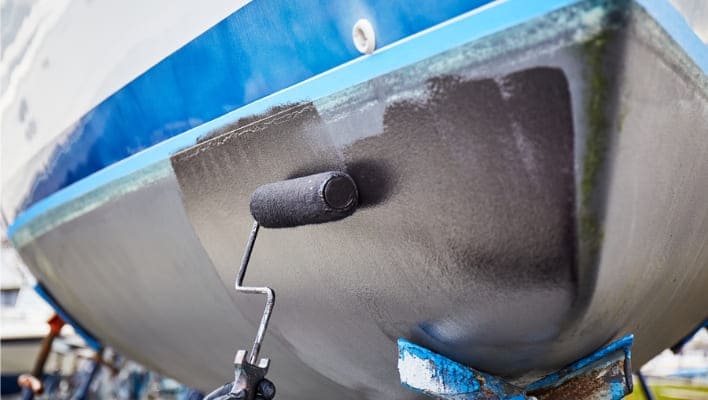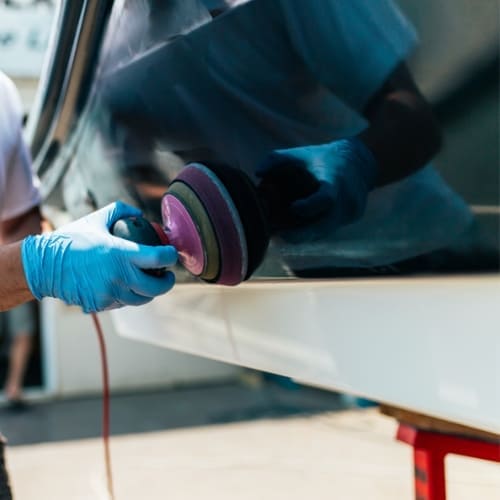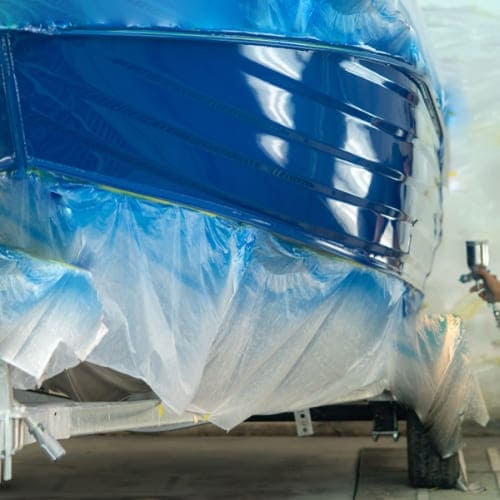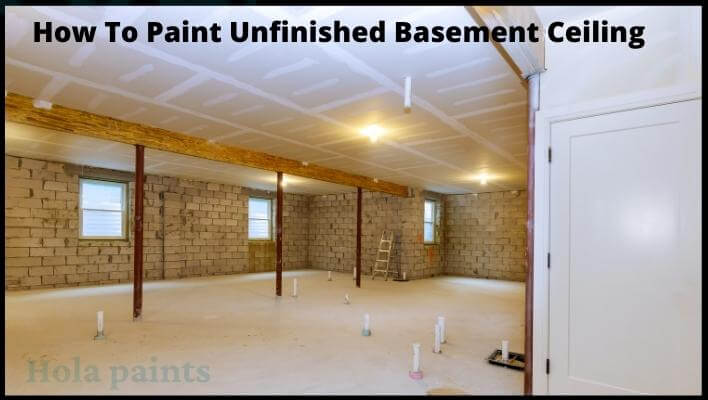Maintaining a boat is an ongoing task that includes many different activities to keep the boat in good shape and working well on the water. One important maintenance job is bottom painting.
This isn’t just about making the boat look good, but more about protecting the lower part of the boat from water damage and things like algae and barnacles that can stick to the boat and slow it down. How much does it cost to bottom paint a boat?
A general guideline to consider when estimating the cost of bottom painting a boat is to allocate around $100 to $150 per linear foot.
Taking an example of a 26-foot boat, you could expect the cost for a quality bottom paint job to fall between $3,250 and $3,900 including all the additional labor costs and materials.

Do you know:
In a $2.4-million study commissioned by Transport Canada, a novel hull paint originating from Nova Scotia was found to deliver remarkable results for fishing boats. This innovative paint not only reduced fuel consumption by an impressive 20%, but it also significantly lowered vessel noise levels by six to seven decibels.
Table of Contents
- Boat Painting Cost
- Professional Cost To Bottom Paint A Boat- Cost Per Linear Foot
- Antifouling Cost Ranges Based on Boat Length
- Labor Costs for Bottom Painting a Boat
- Cost Per Square Foot
- Additional Labor Costs
- DIY Cost To Bottom Paint A Boat
- What kind of paint do you use on the bottom of a boat?
- Epoxy Primer / Barrier Coat
- Ablative Paint ( Base Coat)
- Antifouling paint ( Base Coat)
- 1-Part Polyurethane Paint
- Gel Coat (Top Coat)
- Best bottom paint for boats
- Is bottom paint necessary in freshwater?
- Why do people paint bottom of boats?
- Final Thoughts
- FAQs On How much does it cost to paint a boat?
- Q. What is the duration of painting a boat’s bottom?
- Q. Is bottom painting a boat beneficial?
- Q. Can bottom paint impact a boat’s speed?
- Q. Is bottom paint necessary in freshwater?
- Rosalie Sanchez
Boat Painting Cost
The cost of antifouling bottom painting a boat varies based on different aspects which include the boat size, the quality of paint utilized, and no matter if you decide to do it yourself or get it done by experts. There are many choices! Here’s a breakdown of the costs you might incur:
Professional Cost To Bottom Paint A Boat- Cost Per Linear Foot
The cost of hiring a professional company to paint a boat can vary widely depending on various factors such as the size of the boat, the type of paint used, the condition of the boat, and the region or marina where the work is being done.
Professional services generally charge by the linear foot, with costs ranging from $100 to $150 per linear foot. However, this rate can be higher in certain regions or marinas, or for highly experienced professionals.
For an average boat of 20 feet, you might need to set aside from $2,500 to $3,000, but costs can reach upto $5,000 depending on the various factors;
- Boat Size
- Condition of the Hull
- Type of Paint
- Labor Costs
- Additional Services
- Geographic Location
- Choice of Professional Service
- Environmental Regulations
Antifouling Cost Ranges Based on Boat Length
The cost of professional bottom painting can also be estimated based on the boat’s length:
| Boat Length | Antifouling Cost Ranges |
| 20 feet | $2,500 – $3,000 |
| 25 feet | $3,125 – $3,750 |
| 30 feet | $3,750 – $4,500 |
| 35 feet | $4,375 – $5,250 |
| 40 feet | $5,000 – $6,000 |
Labor Costs for Bottom Painting a Boat
Boat maintenance labor costs, particularly for painting, may surprise new owners. A quote like $35 per foot often covers estimated labor, with additional charges possible for unexpected issues. Responsible marinas typically communicate extra costs resulting from unforeseen work.
The overall labor expense varies based on the boat’s size and the job’s scope. A professional may dedicate 10-20 hours to bottom painting, with labor rates ranging from $50 to $100 per hour.
Cost Per Square Foot
Some professionals charge by the square foot, with rates typically ranging from $15 to $25 per square foot. For example, if your boat has a bottom surface area of 300 square feet, you might be looking at a labor cost of $4,500 to $7,500 at these rates.
Additional Labor Costs

There could be additional labor costs if the boat needs extra preparation work before painting. This might include sanding, scraping off old paint, or repairing any damage to the hull. Professionals might charge an hourly rate for this type of work, often ranging from $50 to $100 per hour.
DIY Cost To Bottom Paint A Boat
If you decide to undertake a bottom painting project on your own, using a single-stage polyurethane paint followed by a gel coat or ‘hot coat’ for an added layer of shine and protection, the costs can vary widely based on the size of your boat and the quality of paint you choose.
The typical cost range for a DIY bottom painting project can be anywhere from $300 to $2000.
This cost primarily covers the paint and the gel or hot coat, but the expense can rise if you select higher-end materials designed to provide superior protection against saltwater and other marine elements.
The bottom paint might be priced higher compared to topside paint due to its specialized formulation designed to withstand harsh marine conditions.
What kind of paint do you use on the bottom of a boat?
Selecting the appropriate paint for bottom painting a boat is important for guarding against marine growth and corrosion. Usually, antifouling paints are used to prevent the buildup of organisms on the boat’s hull.
These paints often incorporate biocides to discourage marine life. However, it is recommended to seek guidance from professionals or consult the boat paint manufacturer’s recommendations for the most suitable product based on your specific boating conditions and preferences.
Boat painting typically involves these steps, as mentioned below:
Epoxy Primer / Barrier Coat
Epoxy primer is tough stuff and works great for patching up fiberglass because it dries hard. Moreover, such a surface can serve as an ideal foundation for applying additional layers of paint.
These primers are an excellent choice for making repairs and preparing the boat’s surface for paint. They provide a strong, moisture-resistant foundation that improves adhesion of topcoats. They’re typically used on fiberglass and metal surfaces to prevent corrosion and water damage.
Barrier coats are ideal for preventing osmosis in fiberglass hulls. They create a protective shell that blocks water penetration, which is important for maintaining the integrity and longevity of your boat. They also provide a smooth surface for applying antifouling or topside paint, making them a good first step in the painting process.
Ablative Paint ( Base Coat)

Ablative paints are great for boats that are used frequently. Over time, it wears off slowly, making it harder for nasty critters like barnacles to stick to your boat.
It’s a low maintenance choice as it self-polishes and doesn’t build up layers over time.
Antifouling paint ( Base Coat)
Antifouling paint is specially designed to prevent the growth of marine organisms on a boat’s hull. It creates a smooth, protective barrier that inhibits barnacles and algae, enhancing a boat’s performance and fuel efficiency.
| Feature | Antifouling Paint | Ablative Paint |
| Function | Prevents marine growth on the hull, such as barnacles and algae. | Releases a biocide or coating as the paint wears away to prevent fouling. |
| Longevity | Typically provides longer-lasting protection. May not require frequent reapplication. | Designed to wear away over time, requiring periodic reapplication. |
| Application | Applied in multiple coats; some types require a primer. | Usually applied as a single coat; no primer needed in most cases. |
| Performance Over Time | Effective for a longer duration but may lose effectiveness with time. | Continually releases fresh biocide as it wears, providing consistent protection. |
| Maintenance | Requires occasional cleaning and repainting. | Relatively low maintenance, but may need more frequent reapplication. |
| Cost | Initial cost can be higher, but less frequent repainting can offset expenses. | Reduced initial expenses, but it might necessitate more frequent repainting |
| Environmental Impact | Some types can have a higher environmental impact due to biocides. | In general, it’s regarded as eco-friendly due to the lower release of harmful substances. |
| Suitable Boat Types | Suitable for boats that spend extended periods in the water. | Great for boats with shorter usage periods and those that are hauled out often. |
| User Skill | Typically requires more skill for application and maintenance. | Easier to apply, making it suitable for DIY boat owners. |
1-Part Polyurethane Paint
The one-part polyurethane paints are a go-to for many due to their ease of application and durability. They give a high-gloss finish that’s resistant to staining and abrasion.
They are also easier to clean compared to other types, making them a user-friendly option for new boat owners.
Gel Coat (Top Coat)
Gel coat is a protective layer applied to the boat’s surface. It shields the boat from environmental elements. Combining antifouling paint and gel coat ensures a well-maintained and clean vessel, prolonging its life and maintaining its aesthetic appeal. These two components are fundamental for any boat owner.
Best bottom paint for boats
| Property | Interlux Bottomkote NT | Pettit Odyssey Triton | TotalBoat Underdog |
| Type | Hard Copper-based | Ablative | Hybrid Antifouling |
| Performance | Excellent Protection | Consistent Performance | Balanced Performance |
| Longevity | 1-2 Seasons | Full Season or More | Full Season or More |
| Application | Easy to Apply | User-Friendly | Balance of Ease |
| Environmental Impact | Copper Leaching Concerns | Ablative (Gradual) | Moderate Environmental |
| My Recommendation | Great for sailboats and power boats | Great For Aluminum boats | Ideal for boats frequently in use |
Is bottom paint necessary in freshwater?
Bottom painting a boat with antifouling paints is typically unnecessary in two primary scenarios. Firstly, if you store your boat on a trailer, lift, or in a dry storage facility, rather than keeping it in the water for extended periods, there may be no need for bottom painting. In such cases, the boat is not exposed to the conditions conducive to the growth of marine organisms on the hull.
Secondly, if your boat is consistently stored out of the water, such as on a trailer or in dry storage when not in use, using bottom paint might not be necessary. This is because regular maintenance becomes more manageable, and you can easily remove any aquatic growth that may occur between uses.
In both situations, the crucial factor is the absence of prolonged water exposure, minimizing the risk of fouling. As a result, bottom painting becomes unnecessary, allowing boat owners to concentrate on other maintenance aspects without requiring antifouling treatments.
Why do people paint bottom of boats?
Boat owners apply bottom paint to the submerged portion of their vessels for various crucial reasons. Firstly, the practice of anti-fouling, utilizing paints with specific chemicals, deters the accumulation of marine organisms like barnacles, algae and seaweeds. This not only maintains the boat’s performance by preventing drag but also ensures a more efficient and streamlined movement through the water.
Moreover, bottom paint serves as a protective shield against corrosion. Continuous exposure to water can result in rust and various forms of corrosion, especially for metal hulls. By applying this protective coating, boat owners significantly reduce the risk of structural weakening over time.
The enhanced efficiency of a smoothly painted hull contributes to fuel efficiency, a vital factor, especially for larger vessels with significant fuel costs. The reduction of friction as the boat moves through the water translates into tangible economic benefits.
In addition to functional advantages, the aesthetic aspect also plays a role in bottom painting. Many boat owners choose to paint the hull for personalization and visual appeal.
Notably, antifouling paint is crucial for preventing wood rot, especially in boats exposed to water year-round or during extended anchor periods. Maintenance intervals vary, with an annual bottom painting recommendation for boats in constant use, and a 2-3 year interval for those in and out of the water.
Final Thoughts
Bottom painting is an important step to keep your boat safe and smooth on water. Whether done by a professional or by yourself, it requires a good amount of money, but it’s a worthy investment. The cost depends on your boat’s size, the paint quality, and who does the job.
Each paint type has its own price, and you may need to pay extra for fixing any damage before painting. Though it may seem a lot, learning and estimating how much does it cost to bottom paint a boat ensures it stays in good shape for your water adventures.
FAQs On How much does it cost to paint a boat?
Q. What is the duration of painting a boat’s bottom?
The time it takes to paint the bottom of a boat can change based on how big the boat is and who is doing the painting. Usually, it can take 7 to 10 days to finish the job. The kind of paint used can also affect the time because some paints take longer to dry.
Q. Is bottom painting a boat beneficial?
Bottom painting a boat is beneficial, especially to protect it from the effects of saltwater, which can cause oxidation leading to a change in the hull’s color. For pontoon boat owners, it’s a familiar issue as oxidation occurs fast when the boat stays in water. Fiberglass boats too can face oxidation, making bottom paint a good idea for all boat types.
Q. Can bottom paint impact a boat’s speed?
Bottom paint can reduce your boat’s speed. If your boat’s hull has a smooth, untextured paint finish, the impact of this issue may not be very noticeable. However, if you’ve been applying multiple coats of ablative paint yearly and the boat hasn’t been used much, the accumulated layers can cause a slowdown.
Q. Is bottom paint necessary in freshwater?
In freshwater settings, a particular kind of paint is needed for your boat, often referred to as antifouling bottom paint. There are several benefits to using this paint, making it a key topic for those new to boat maintenance.

Rosalie Sanchez
DIY enthusiast with years of experience in home decor and home improvement. With a passion for educating consumers about DIY projects. Every time, I work with our painting professionals to provide you with the best painting product reviews and how-to advice. You can follow me on Facebook.


